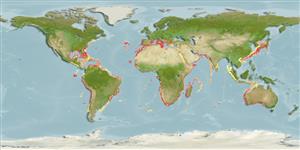Actinopterygii (ray-finned fishes) >
Perciformes (Perch-likes) >
Epigonidae (Deepwater cardinalfishes)
Etymology: Epigonus: Greek, epi = over, in front + Greek, gonio = angle (Ref. 45335).
Environment / Climate / Range
Ecology
Marine; bathydemersal; depth range 130 - 830 m (Ref. 31632), usually 300 - 600 m (Ref. 4738). Deep-water, preferred ?; 43°N - 44°S, 98°W - 142°E
Cosmopolitan. Western Atlantic: Gulf of Mexico and Caribbean Sea. Eastern Atlantic: along the west coast of Africa to the southern tip of the continent, also western Mediterranean to southern Adriatic Sea. Indian Ocean: Reunion (Ref. 33390). Western Pacific: southwest coast of Japan, southern Australia and eastern New Zealand. Central Pacific: Hawaiian Ridge (Ref. 31632).
Size / Weight / Age
Maturity: Lm ? range ? - ? cm
Max length : 20.0 cm TL male/unsexed; (Ref. 4329)
Dorsal
spines
(total): 7;
Dorsal
soft rays
(total): 10;
Anal
spines: 2;
Anal
soft rays: 8 - 9. Lacks opercular spines (Ref. 31632). Membranous edge at upper border of the gill cover is well developed. Caudal peduncle elongated, body not deep (Ref. 31632). Pyloric caeca 10-14. Preserved specimens are brownish to yellowish in color, dorsally darker. Numerous brown-black melanophores on scale pockets.
Adults benthic on the continental slope and collected with bottom trawls (Ref. 7321). Juveniles are pelagic in depths of 130-145 and 350-425 m (Ref. 9563). Feed on small fishes and planktonic invertebrates (Ref. 4738). Oviparous (Ref. 4738).
Life cycle and mating behavior
Maturity | Reproduction | Spawning | Eggs | Fecundity | Larvae
Maugé, L.A. and G.F. Mayer, 1990. Apogonidae. p. 714-718. In J.C. Quero, J.C. Hureau, C. Karrer, A. Post and L. Saldanha (eds.) Check-list of the fishes of the eastern tropical Atlantic (CLOFETA). JNICT, Lisbon; SEI, Paris; and UNESCO, Paris. Vol. 2. (Ref. 7321)
IUCN Red List Status (Ref. 115185)
CITES (Ref. 94142)
Not Evaluated
Threat to humans
Harmless
Human uses
More information
ReferencesAquacultureAquaculture profileStrainsGeneticsAllele frequenciesHeritabilityDiseasesProcessingMass conversion
Tools
Special reports
Download XML
Internet sources
